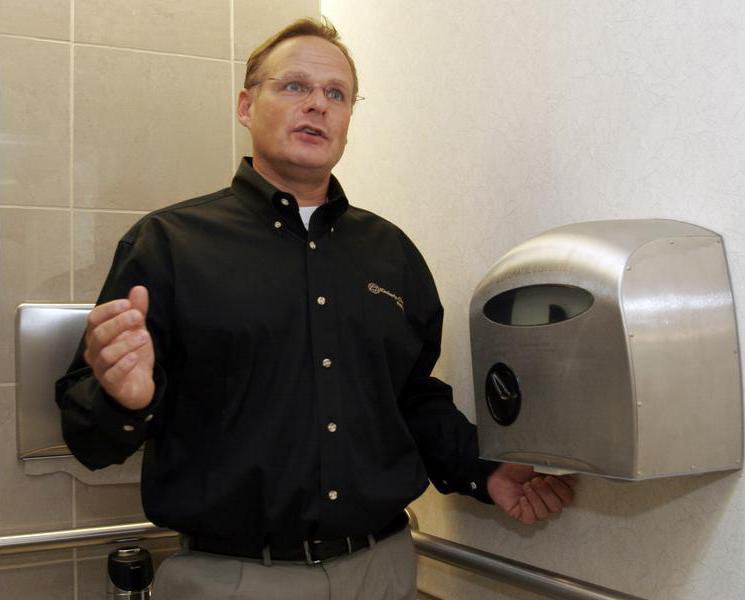ROSWELL, Ga. — Richard Thorne stands grinning in a spacious stall in a women’s restroom.
‘‘As Captain Kirk says, ’We’re boldly going where no man has gone before,’’’ he says, waving his hand under a toilet paper dispenser. The machine spits five sheets of tissue into his grasp.
Is this, as Thorne claims, the final frontier of a touchless bathroom?
A year in the works, the electronic tissue dispenser is being rolled out to the masses by Kimberly-Clark Professional as it seeks to capture more of the $1 billion away-from-home toilet paper market. The company, based in Roswell, Ga., hopes units like the one at its office will one day fit in with the automatic toilets, faucets and paper towel machines that have become a norm in many other office and institutional bathrooms.
‘‘The one part of the room where there’s not an automatic option is toilet tissue,’’ says Thorne, director of the company’s washroom business.
When one of the two motion sensors is activated, the device’s battery-powered motor automatically dispenses a predetermined amount of toilet paper.
The tricky part was deciding how much. To get the answer, the company turned to focus groups and years of internal research.
Americans typically use twice as much toilet paper as Europeans — as much as an arm’s length each pull, says Thorne.
The company decided the best length is about 20 inches — or precisely five standard toilet paper squares. But the machine can also be preset to churn out 16 inches or 24 inches, depending on the demand.
‘‘Most people will take the amount given,’’ says Thorne. Waxing philosophical, he adds, ‘‘People generally in life will take what you give them.’’
The machine isn’t completely automated. Each also comes with a suite of ‘‘security’’ features in case the machine malfunctions.
There’s an emergency feed button, and a manual feed roller lets the users pull the roll around if the motor breaks down or the 4-D batteries run out. There’s also an option for a ‘‘rescue roll’’ on one side of the machine just in case the old-fashioned way is preferred.
‘‘This is probably the most personal experience you can have. We didn’t want to get any frustrations,’’ Thorne says. ‘‘None of us like to touch things they think someone before them has touched.’’
The devices cost about $30 apiece for the plastic variety, and $55 if cased in stainless steel. Kimberly-Clark marketers say each machine could save users 20 percent of toilet paper annually.
Sean Nichols, one of the lead marketers for the device, says he’s banking on the ‘‘coolness, the newness of the unit.’’
He’s sending some to late night comedians and hoping for TV exposure. He also hopes the devices will appeal to clean-freaks, such as Tony Shalhoub’s obsessive compulsive germophobe character on the USA Network’s ‘‘Monk.’’
But Thorne admits the company won’t truly achieve a ‘‘touchless’’ bathroom until it develops a toilet that does the dirty work for you.
‘‘And that,’’ he says, ‘‘is going to be interesting.’’
———
On the Net:
http://www.kimberly-clark.com/
‘‘As Captain Kirk says, ’We’re boldly going where no man has gone before,’’’ he says, waving his hand under a toilet paper dispenser. The machine spits five sheets of tissue into his grasp.
Is this, as Thorne claims, the final frontier of a touchless bathroom?
A year in the works, the electronic tissue dispenser is being rolled out to the masses by Kimberly-Clark Professional as it seeks to capture more of the $1 billion away-from-home toilet paper market. The company, based in Roswell, Ga., hopes units like the one at its office will one day fit in with the automatic toilets, faucets and paper towel machines that have become a norm in many other office and institutional bathrooms.
‘‘The one part of the room where there’s not an automatic option is toilet tissue,’’ says Thorne, director of the company’s washroom business.
When one of the two motion sensors is activated, the device’s battery-powered motor automatically dispenses a predetermined amount of toilet paper.
The tricky part was deciding how much. To get the answer, the company turned to focus groups and years of internal research.
Americans typically use twice as much toilet paper as Europeans — as much as an arm’s length each pull, says Thorne.
The company decided the best length is about 20 inches — or precisely five standard toilet paper squares. But the machine can also be preset to churn out 16 inches or 24 inches, depending on the demand.
‘‘Most people will take the amount given,’’ says Thorne. Waxing philosophical, he adds, ‘‘People generally in life will take what you give them.’’
The machine isn’t completely automated. Each also comes with a suite of ‘‘security’’ features in case the machine malfunctions.
There’s an emergency feed button, and a manual feed roller lets the users pull the roll around if the motor breaks down or the 4-D batteries run out. There’s also an option for a ‘‘rescue roll’’ on one side of the machine just in case the old-fashioned way is preferred.
‘‘This is probably the most personal experience you can have. We didn’t want to get any frustrations,’’ Thorne says. ‘‘None of us like to touch things they think someone before them has touched.’’
The devices cost about $30 apiece for the plastic variety, and $55 if cased in stainless steel. Kimberly-Clark marketers say each machine could save users 20 percent of toilet paper annually.
Sean Nichols, one of the lead marketers for the device, says he’s banking on the ‘‘coolness, the newness of the unit.’’
He’s sending some to late night comedians and hoping for TV exposure. He also hopes the devices will appeal to clean-freaks, such as Tony Shalhoub’s obsessive compulsive germophobe character on the USA Network’s ‘‘Monk.’’
But Thorne admits the company won’t truly achieve a ‘‘touchless’’ bathroom until it develops a toilet that does the dirty work for you.
‘‘And that,’’ he says, ‘‘is going to be interesting.’’
———
On the Net:
http://www.kimberly-clark.com/

